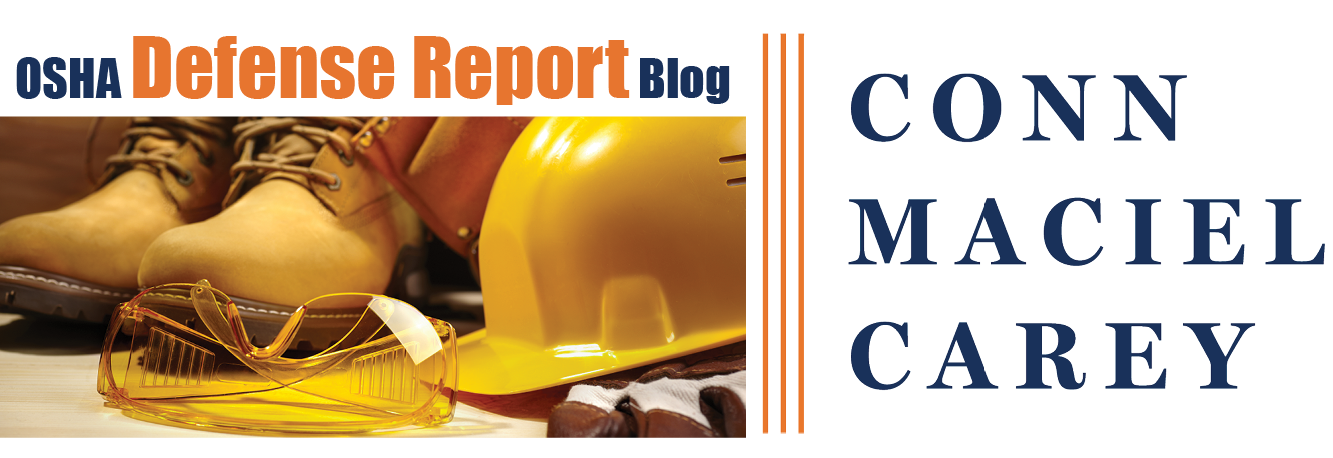By Conn Maciel Carey’s COVID-19 Task Force
Many of you are likely knee-deep in ensuring that your facilities are in compliance with the various components of OSHA’s new Emergency Temporary Standard, with the July 6th compliance deadline nearly upon us. Our CMC COVID-19 Taskforce has reviewed all 1,000+ pages of OSHA’s ETS and supporting documentation and has as good an understanding of what is required as one can have – although OSHA has left some big question marks and caused a fair amount of head scratching in some areas. To help you understand precisely what is required of your covered facilities, and to assist with compliance implementation, we have prepared summaries of the major requirements of the ETS. Look for our summaries here each day over the next week. The devil is in the details, however, so please reach out if you would like a more nuanced understanding of how the standard applies to your particular facility and what steps you need to take to ensure you are in compliance – and avoid an enforcement action under OSHA’s COVID-19 National Emphasis Program.
One of the first steps employers must take is to conduct a hazard assessment of your operations to determine those areas where risk of virus transmission exists, and to then develop a response plan for dealing with those risks. The hazard assessment findings and your plans for transmission mitigation must be incorporated into a written COVID-19 Plan. Here is a summary of the ETS requirements for conducting the hazard assessment and preparing a written plan:
29 C.F.R. Section 1910.502(c) requires all employers covered by the ETS to develop and implement a COVID-19 Plan for each workplace. If the employer has more than 10 employees, the Plan must be written. This summary describes the requirements associated with the COVID-19 Plan.
Before developing the Plan, employers must conduct a workplace specific hazard assessment for the purpose of identifying and understanding where potential COVID-19 hazards exist and what controls must be implemented to reduce those hazards. Employers must inspect the entire workplace and the hazard assessment should:
- Evaluate employees’ potential workplace exposure to all people at the workplace including patients, coworkers, employees of other entities, members of the public, clients, independent contractors, visitors, and other non-employees;
- Identify and address places and times where people may congregate or come in contact with one another;
- Consider how employees and other people enter, travel through, and leave the workplace; and
- Consider the hazards employees are exposed to at fixed work locations.
The hazard assessment should document:
- The identification of “high-risk” area(s), tasks, and occupations;
- A plan to mitigate the identified hazards or risk factors, and set a date by which planned actions should be completed;
- Date(s) the assessment was performed;
- The names and titles of the individuals who participated in the evaluation and contributed to the written plan;
- Communications of the status of planned or completed actions to employees who may be affected by the identified hazards or risk factors;
- For completed mitigation actions:
- what method(s) of control was/were decided upon;
- area(s) where control(s) was/were implemented;
- specific date(s) of completion; and
- the names and titles of the individuals who authorized and managed implementation of control;
After completing the hazard assessment, the Plan must:
- Identify a workplace safety coordinator. The coordinator must be knowledgeable on the workplace infection control practices and have authority to ensure compliance with all aspects of the COVID-19 plan.
- Outline the employer’s policies and procedures to determine employee’s vaccination status, if the employer chooses to exercise an exemption from providing PPE, physical distancing, and physical barriers (where there is a reasonable expectation that no person with suspected or confirmed COVID-10 will be present).
- Address the hazards identified in the hazard assessment by implementing policies and procedures to:
- effectively communicate the COVID-19 Plan and coordinate with other employers to ensure the protection of all employees when employees of different employers share the same work location; and
- protect employees who are required to enter private residences or physical locations controlled by a person who is not covered by the OSH Act, including the process for employee withdrawal from the residence in the event those protections are inadequate.
After the plan is implemented, employers must monitor each of their workplaces to ensure the COVID-19 Plan is effective, and if the employer determines the plan is not effective, make updates as necessary.
We have published several articles about the other sections of the ETS, including:

[…] Hazard Assessments and COVID-19 Plans […]
[…] Hazard Assessments and COVID-19 Plans […]
[…] Hazard Assessments and COVID-19 Plans […]
[…] Hazard Assessments and COVID-19 Plans […]
[…] Hazard Assessments and COVID-19 Plans […]
[…] Hazard Assessments and COVID-19 Plans […]
[…] Hazard Assessments and COVID-19 Plans […]
[…] Hazard Assessments and COVID-19 Plans […]